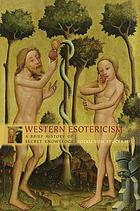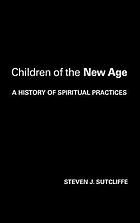
Western esotericism, the belief in occult and hidden knowledge, has existed since antiquity. Esoteric elements are found in many religions, including major world religions such as Christianity (e.g., Gnosticism) and Judaism (e.g., Kabbalah), and small, occult NRMs such as the Theosophical Society and the Order of the Golden Dawn. The most comprehensive general reference source for Western esotericism is the two-volume Dictionary of Gnosis and Western Esotericism, edited by Wouter Hanegraaff. This dictionary covers Gnosticism and esotericism from antiquity to the present. Entries like “Animal Magnetism,” “Byzantium,” and “Hermetic Brotherhood of Luxor” go into great depth concerning their topics (the entry for “Blavatsky, Helena Petrovna,” founder of theosophy, for example, is nine pages long).
Three recently published histories of esotericism are worth seeking out. Kocku von Stuckrad’s Western Esotericism: A Brief History of Secret Knowledge is a broad history of esotericism from the ancient world to the present. NRM-related chapters include essays on esotericism and science, secret societies, the Theosophical Society, and esotericism and modernity. For a more focused account of modern esoteric movements’ impact on Western culture, see John Warne Monroe’s Laboratories of Faith: Mesmerism, Spiritism, and Occultism in Modern France (France is especially important as an incubator for Western esoteric movements).
Occupying some common ground with esotericism, the New Age movement comprises an eclectic variety of groups that often borrow from, yet act as alternatives to established religions, philosophies, and esoteric/occult practices. These groups may also incorporate elements of the physical and social sciences, as well as cultural traditions of indigenous peoples like Native Americans or Native Australians. New Agers, however, are arguably more egalitarian than the more narrowly focused Western esoteric groups such as Christian Gnosticism, and often share a humanistic belief in all people’s innate spiritual potential. One of the most in-depth introductions to the development of both American esoteric and New Age religions is Catherine Albanese’s A Republic of Mind and Spirit: A Cultural History of American Metaphysical Religion. Albanese traces New Age traditions in the United States, examining American adaptations and contributions to movements including spiritualism, theosophy, and those with gurus. Another fine history of the New Age is Steven Sutcliffe’s Children of the New Age: A History of Spiritual Practices. Sutcliffe examines the development of New Age thinking in the last half of the twentieth century, showing its roots in apocalyptical thinking and describing its shift toward becoming a broader spiritual movement. For those seeking to better understand the current state of the New Age movement, two books are particularly useful. The Handbook of New Age, edited by Daren Kemp and James R. Lewis, organizes twenty-two essays around themes of social-scientific research, culture, globalization, and practitioner worldviews. Adam Possamai’s comprehensive study In Search of New Age Spiritualities offers a snapshot of the movements that explores the defining features of modern New Agers.
 Western esotericism: A Brief history of secret knowledge
by
Western esotericism: A Brief history of secret knowledge
by
 Children of the New Age: A History of alternative spirituality
by
Children of the New Age: A History of alternative spirituality
by